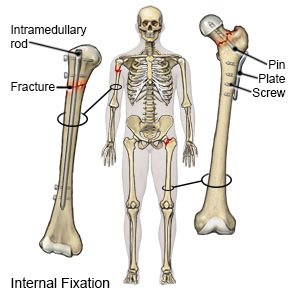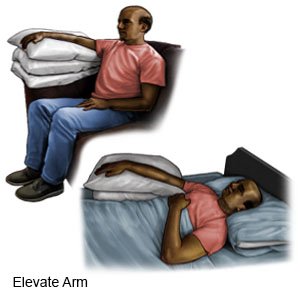Closed Reduction Internal Fixation of an Upper Extremity Fracture
Medically reviewed by Drugs.com. Last updated on Aug 4, 2025.
AMBULATORY CARE:
What I need to know about closed reduction internal fixation (CRIF):
CRIF fixes a fractured (broken) bone without opening the skin over the fracture. Metal plates, rods, screws, pins, or wires are examples of internal fixation devices. They will be used to hold the bones in place while they heal.
 |
Prepare for a CRIF:
Your healthcare provider will talk to you about how to prepare for surgery. He or she may tell you not to eat or drink anything after midnight the day before your surgery. You will also be told what medicines to take or not take on the day of your surgery. Arrange to have someone drive you home after surgery. You will not be able to drive yourself.
What will happen during a CRIF:
You may be given local anesthesia that numbs the body area where the surgery will be done. With local anesthesia, you will remain awake or lightly sedated during surgery. You may feel pressure or pushing during surgery, but you should not feel any pain. Your healthcare provider will use an x-ray machine to see your broken bone. The x-ray machine will show pictures on a monitor. Your healthcare provider will be able to watch the monitor while putting the pieces of bone in the correct position. Incisions will be made in the areas where the internal fixation devices will be inserted. Internal fixation devices will be placed through the incisions, into the side of the broken bones. The incisions may be closed with stitches. A splint or cast may placed to protect your surgery area.
What will happen after my surgery?
Your healthcare provider will monitor you for a short time after surgery. The area will remain numb for up to 6 hours. It is normal to have pain. Take your pain medicines before the numbness wears off completely. You may also notice swelling and bruising. The devices may be removed once your fracture starts to heal. The devices may instead be left in place. You may need to participate in physical or occupational therapies. These therapies will teach you exercises to keep range of motion in your arm.
Risks of a CRIF:
- You may bleed more than expected or get an infection. Your healthcare provider may not be able to position your fracture correctly using a closed procedure. After surgery, your broken bone may not heal correctly. You may continue to have pain. The internal fixation devices may break or change shape. You may need another surgery to remove the device used to hold your bones in place. Nerves, blood vessels, ligaments, or muscles may be damaged during surgery.
- You may develop a fat embolus. This is when fat is forced out of the inside of the bone and travels to other parts of your body. It can block blood flow to your lungs, brain, or heart. You may get a blood clot in your arm. This may become life-threatening.
Call your local emergency number (911 in the US) for any of the following:
- You feel lightheaded, short of breath, or have chest pain.
- You cough up blood.
Seek care immediately if:
- Your arm or leg feels warm, tender, and painful. It may look swollen and red.
- You have severe pain, even after you take medicine.
- Your stitches come apart.
- Your cast or splint breaks.
- You cannot move your arm or fingers.
- You have tingling or numbness in your arm or fingers.
Call your doctor or orthopedist if:
- You have a fever or chills.
- Your cast or splint gets wet or begins to smell.
- Your bandage or cast feels too tight or too loose.
- You have a lot of itching under your cast or splint.
- Your incision is red, swollen, or draining pus.
- You have questions or concerns about your condition or care.
Self care after surgery:
- Apply ice to the area. Ice helps decrease swelling and pain. Ice may also help prevent tissue damage. Use an ice pack or put crushed ice in a plastic bag. Cover it with a towel and place it on your fractured area for 15 to 20 minutes every hour as directed.
- Elevate your arm as directed. Raise your arm above the level of your heart as often as you can. This will help decrease swelling and pain. Prop your arm on pillows or blankets to keep it elevated comfortably.

- Ask about activity. Ask your healthcare provider when you can return to your daily activities and go back to work.
- Eat foods with calcium and vitamin D. Calcium and vitamin D help fractures heal. Examples of high calcium foods include kale, spinach, salmon, and fortified orange juice and some breakfast cereals. Examples of foods high in vitamin D include tuna, fortified milk, some cheeses, egg yolks, and soy milk.

- Do not smoke. Nicotine and other chemicals in cigarettes and cigars can increase your risk for infection and slow down wound healing. Ask your healthcare provider for information if you currently smoke and need help to quit. E-cigarettes or smokeless tobacco still contain nicotine. Talk to your healthcare provider before you use these products.
- Physical therapy is used to teach you exercises to help improve movement and strength, and to decrease pain.
Cast or splint care:
If you have a cast or splint, do the following:
- Place a plastic bag over your cast when you take a shower. Tape the plastic bag to your skin to keep water away from your cast or splint.
- Check the skin around the cast or splint every day. Apply lotion on any red or sore areas.
- Do not push down or lean on any part of the cast or splint. It may break or move the injured area.
- Do not scratch the skin under the cast with any sharp or pointed object inside the cast.
- If your splint is too tight, gently loosen it so that your fingers are comfortable.
Follow up with your doctor or orthopedist as directed:
Write down your questions so you remember to ask them during your visits.
© Copyright Merative 2025 Information is for End User's use only and may not be sold, redistributed or otherwise used for commercial purposes.
The above information is an educational aid only. It is not intended as medical advice for individual conditions or treatments. Talk to your doctor, nurse or pharmacist before following any medical regimen to see if it is safe and effective for you.
Further information
Always consult your healthcare provider to ensure the information displayed on this page applies to your personal circumstances.
